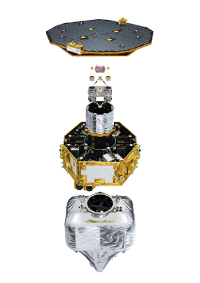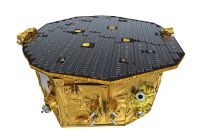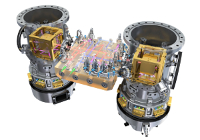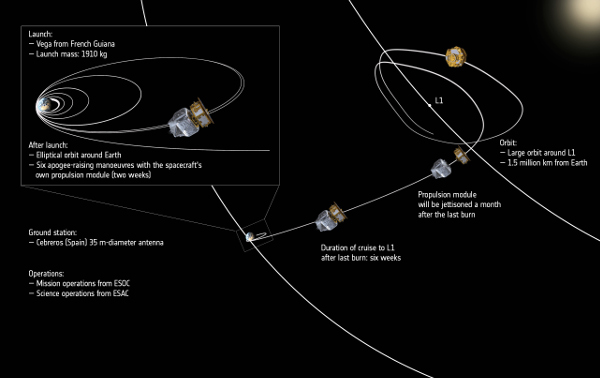Fact Sheet
 |
|
||||||||||||||
|
LISA Pathfinder is testing in flight the concept of low-frequency gravitational wave detection: it has put two test masses in a near-perfect gravitational free fall, and is controlling and measuring their motion with unprecedented accuracy. To do this it uses inertial sensors, a laser metrology system, a drag-free control system and an ultra-precise micro-propulsion system.
Mission Objectives
The aim of the LISA Pathfinder mission is to demonstrate, in a space environment, that free-falling bodies follow geodesics in space-time, by more than two orders of magnitude better than any past, present, or currently planned mission. Specifically, it must:
- Demonstrate drag-free and attitude control in a spacecraft with two free test masses
- Test feasibility of laser interferometry with picometre resolution at low frequency – approaching 10-12 m Hz-1/2 in the frequency band 1-30 mHz
- Test the endurance of the different instruments and hardware in the space environment
Mission Name
The name LISA in the mission name comes from Laser Interferometer Space Antenna, an earlier concept for a spaceborne observatory for gravitational waves, and now used to describe a class of missions based on the original LISA concept. LISA Pathfinder is testing key technologies for future LISA-like space missions to study the gravitational Universe.
Spacecraft
LISA Pathfinder has a main science spacecraft and a separable propulsion module. The propulsion module was used to raise the orbit of LISA Pathfinder after launch and to propel the spacecraft to its operational orbit at L1. The propulsion module was then jettisoned since it would be a source of unwanted forces on the science spacecraft during science operations. The science spacecraft carries the LISA Technology Package (LTP) and Disturbance Reduction System (DRS), and is covered with one single fixed solar array.
Payload
The science spacecraft carries two test packages:
- LISA Technology Package (LTP): The LTP contains two identical test masses in the form of 46 mm gold:platinum cubes, each suspended in its own vacuum container. They act both as mirrors for the interferometer and as inertial references for the drag-free control system.
-
Disturbance Reduction System (DRS): The DRS is a NASA-supplied system comprising two clusters of colloidal micro-propulsion thrusters and an electronic unit containing a computer with associated drag-free control software.
 |
 |
 |
|
Left: Exploded view of the LISA Pathfinder spacecraft. Above left: The LISA Pathfinder science module, and (right) the LISA Technology Package core assembly. Credit: ESA/ATG medialab |
||
Orbit
LISA Pathfinder was launched into a slightly elliptical parking orbit. Using its own propulsion module it progressively expanded its Earth orbit over a period of two weeks before beginning the cruise phase to its operational orbit. The spacecraft will operate in a Lissajous orbit around the first Sun-Earth Lagrange point, L1. After the last transfer burn was performed, and the health of the science spacecraft ascertained, the propulsion module was jettisoned.
 |
| LISA Pathfinder's journey through space. Credit: ESA/ATG medialab |
Operations Centre
The Mission Operations Centre is at the European Space Operations Centre (ESOC) in Darmstadt, Germany. The Science and Technology Operations Centre is located at the European Space Astronomy Centre (ESAC) at Villaneuva de la Cañada in Spain and is re-located to ESOC during LISA Pathfinder operations.
Participants
LISA Pathfinder was built by an industrial team led by prime contractor, Airbus Defence and Space Ltd. Airbus Defence and Space GmbH is responsible for providing the integrated LISA Technology Package (LTP) payload. The subsystems for the LTP are provided by a consortium of European companies, research institutes, and ESA.
